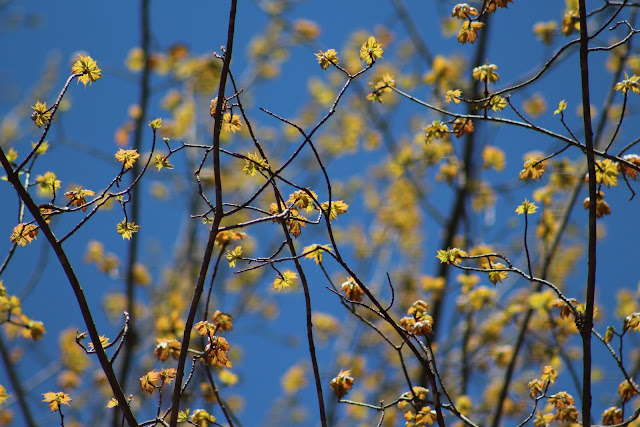Happy Mother's Day! We haven't made much progress toward spring this week as we've had cold and wet weather for days. Even though the calendar says May, it has been a lot more "April Showers" than "brings May Flowers". But everything is primed and ready to pop when we get that next warm stretch.
As the saying goes, it has been good weather for ducks, and there have been quite a few around. Mallards are plentiful as always, but several pairs of wood ducks also appear to have taken Lake Wicwas as their choice to raise their families.
 |
| A handsome couple |
A pair of female mergansers that missed the
dating party earlier this spring have been hanging around, looking for love.
 |
| Where did all the guys go? |
The cool weather has kept tic sightings down, but they are out there, tiny and difficult to see at this time of year.
 |
| A deer tic the size of poppy seed on a stalk of grass looking for a ride |
 |
| He didn't find one (R.I.P.) (I wouldn't last long working for uber) |
Other, more helpful insects are appearing as well, including this cool little Common Water Strider.
 |
| Common Water Strider (Aquarius remigis) |
It has enough mass to make dents in the water, yet it manages to stay dry, using the surface tension property of water to walk right on top of it. The middle and rear legs have evolved to be very long and are covered with thousands of tiny hairs, the combination of which distributes its weight over a large area of water.
[Ref: Ward, J.V. (1992). Aquatic Insect Ecology: 1. Biology and habitat. New York: Wiley & Sons.] The short front legs are used to capture and puncture food which consists of spiders and insects that fall onto the lake. [Ref:
Williams, D. & Feltmate, B. (1992). Aquatic insects. CAB International.] They eat mostly live insects, but will consume dead ones as well. So we can consider these beneficial insects, keeping down the insect population, as well as scouring up refuse that collects on the surface of the lake. It's nature's miniature version of
Mr. Trash Wheel. (An innovative, automated solar-powered trash collector that can extract 50,000 pounds of trash a day from Baltimore Harbor - worth checking out if you haven't seen it. Click on Mr. Trash Wheel above, or
here.)
More of the summer birds are arriving every day to do their part in controlling the insect population. The yellow-rumped warbler is one of the most abundant of the warblers, but will soon be near impossible to see, hiding high in the canopy of the trees.
 |
| Yellow Rumped Warbler (Setophaga coronata) |
After hearing the loons for quite some time, I had my first sighting.
There were two loons, acting like a pair, but a third was in the mix as well. I haven't seen any leg bands so I don't know if these are our loons, transients, or perhaps hopeful residents-to-be.
After last year's sad story with the loons (see
post from October 18), I hope our pair didn't decide to move on to a different neighborhood.





















































